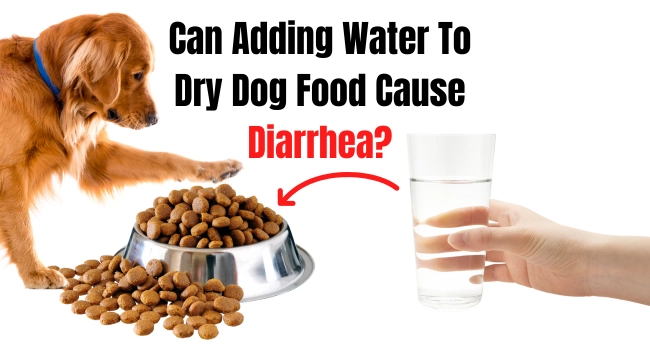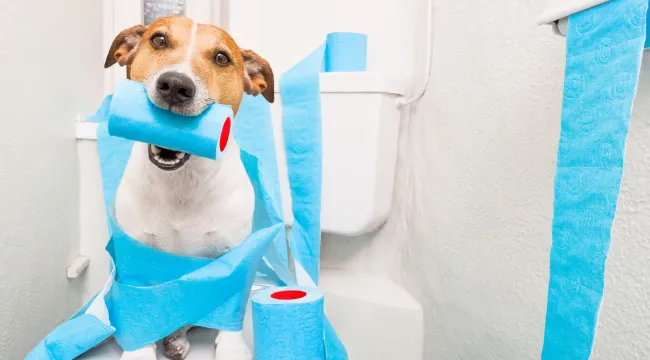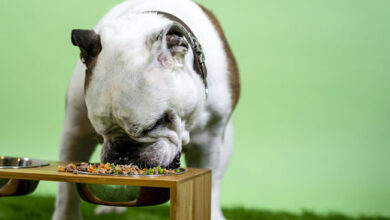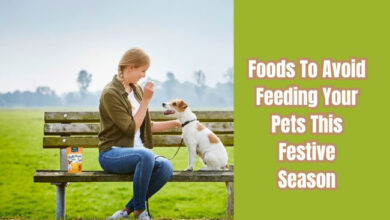
Are you wondering, “Can adding water to dry dog food cause diarrhea?” If the thought of those crunchy kibbles makes you wince and you’re eager to provide a more comfortable mealtime, you’re on the right track.
Many pet owners worry that dry dog food might be too tough on their canine’s teeth, especially for puppies and older dogs. But fear not, as your dog’s teeth are more than capable of handling the challenge. Yet, if you still find yourself wondering whether adding water to your dog’s food could lead to tummy troubles like diarrhea, you’re in the right place.
This article is here to address your concerns and provide all the information you need about this feeding practice. We’ll explore the benefits, potential drawbacks, and proper ways to incorporate water into your dog’s meal. Whether you’re aiming to improve digestibility, boost hydration, cater to a picky eater, or promote better dental health, let’s delve into the details of adding water to dry dog food.
Is Adding Water to Your Dog’s Dry Food a Good Idea?
Adding water to your dog’s dry food can be a good idea for several reasons, but it’s important to consider your dog’s health, dietary needs, and preferences. Here’s a breakdown of why you might want to add water to dry dog food and things to keep in mind:
Benefits of Adding Water to Dry Dog Food
- Hydration: Many dogs do not drink enough water on their own. Adding water to their food can help increase their hydration levels, which is especially beneficial for dogs with kidney issues or those prone to urinary tract infections.
- Ease of Eating: For puppies, senior dogs, or dogs with dental issues, softened food can be easier to chew and swallow.
- Digestion: Adding water to dry food can aid digestion by helping to break down the food before it’s consumed, making it easier for the dog to digest.
- Palatability: Some dogs may find moistened food more appealing, which can be particularly useful for picky eaters or dogs with a reduced appetite.
- Temperature Regulation: In hot weather, adding water to dry food can help keep dogs cooler by increasing their water intake.
Considerations and Tips
- Gradual Introduction: If you decide to add water to your dog’s food, introduce this change gradually to avoid digestive upset. Start with a small amount of water and gradually increase to the desired level.
- Quality of Dog Food: Ensure the dry food is of high quality. Adding water to lower-quality foods might cause the food to spoil more quickly or become less appealing to your dog.
- Amount of Water: The amount of water you add should be based on your dog’s preference and the need for additional hydration. Too much water can make the food too soggy for some dogs’ liking.
- Freshness: Once water is added to dry food, it should be consumed within a short time to prevent bacterial growth. Do not leave moistened food out for more than an hour, especially in warm environments.
- Consult Your Vet: If your dog has specific health concerns or dietary needs, consult your veterinarian before making changes to their diet, including adding water to their dry food.
In summary, adding water to your dog’s dry food can offer health benefits and make meals more enjoyable for your pet. However, it’s important to proceed with care, considering your dog’s specific needs and any potential changes in their digestion or eating habits.
Can Adding Water To Dry Dog Food Cause Diarrhea?

Adding water to dry dog food can sometimes cause diarrhea in dogs, but this isn’t always the case. It largely depends on the dog’s digestive system and how it reacts to the change. Here’s why:
- Hydration: Moistening dry food can help with hydration, especially in dogs that don’t drink enough water on their own. This can be particularly beneficial for dogs with urinary tract issues.
- Digestibility: For some dogs, especially puppies, seniors, or those with dental problems, adding water to dry food can make it easier to chew and digest.
- Sudden Change: If a dog is not used to having water added to their food and it’s introduced suddenly, it could disrupt their digestive system. Dogs’ digestive systems are sensitive to changes in their diet. It’s best to introduce any new food or changes in food preparation gradually over several days.
- Food Quality: The quality of the dry food also matters. Some foods may expand more than others when water is added, potentially causing discomfort or indigestion.
- Amount of Water: Adding too much water could also potentially lead to diarrhea if the dog’s diet suddenly becomes too high in moisture, altering the balance of their gut flora.
If you’re considering adding water to your dog’s dry food, it’s best to start with a small amount to see how your dog reacts. If diarrhea or any other digestive issues occur, reduce the amount of water or consult with a veterinarian to ensure there’s not a more serious underlying issue. Remember, each dog is unique, and what works for one may not work for another.
Related Post: Should Puppies Eat Dry or Wet Food?
Causes of Dog Diarrhea When Adding Water to Dry Food
When adding water to your dog’s dry food, several factors could potentially contribute to the development of diarrhea. It’s important to be aware of these potential causes and take steps to minimize the risk. Here are some common reasons why a dog might experience diarrhea when water is added to their dry food:
1. Sudden Diet Change: Abruptly introducing water to your dog’s dry food without a gradual transition can disrupt their digestive system, leading to diarrhea. Dogs are sensitive to dietary changes, and a sudden switch in their routine can cause gastrointestinal upset.
2. Hygiene Issues: Using unclean water or contaminated utensils can introduce bacteria or pathogens into your dog’s food, leading to digestive disturbances.
3. Overhydration: Adding too much water to your dog’s dry food can dilute their stomach acids and enzymes, making it harder for them to digest the food properly. This can potentially result in diarrhea.
4. Underlying Sensitivities or Allergies: Some dogs may have food sensitivities or allergies that can be triggered by certain ingredients in their dry food or the water added to it. This can lead to digestive issues, including diarrhea.
5. Low-Quality Food: Poor-quality dry food with low nutritional value or excessive fillers can be harder for dogs to digest, especially when water is added. This can contribute to digestive upset.
6. Bacterial Contamination: If the kibble or the water used is contaminated with harmful bacteria, it can lead to gastrointestinal infections and diarrhea.
7. Portion Control: Overfeeding, whether with dry or moistened food, can overwhelm your dog’s digestive system and lead to diarrhea.
8. Preexisting Health Conditions: Dogs with certain preexisting health conditions, such as sensitive stomachs, gastrointestinal disorders, or inflammatory bowel disease, may be more prone to experiencing diarrhea when their diet is modified.
9. Electrolyte and Nutrient Imbalance: When you mix water with your dog’s food, it can mess up the balance of important stuff like electrolytes and nutrients, which might upset their tummy.
Even if your pup drinks water separately while eating, the same issue can happen. That water and the wet food all end up in the same spot – your dog’s belly.
10. Watch Out for Overfeeding: Adding water to your dog’s food might lead to diarrhea if you give them too much. You see, water takes up space, and a dog’s tummy has its limits. All that extra volume can make their tummy upset and mess with their digestion, leading to diarrhea.
To prevent this, start by giving your dog a little less food than usual. If they finish it and still seem hungry, you can add a bit more to their bowl each day. This way, you can keep their tummy happy and avoid any tummy troubles.
To help prevent diarrhea when adding water to your dog’s dry food, consider the following precautions:
- Gradually introduce water to their food over a period of several days.
- Use clean, fresh water and clean utensils for mixing.
- Monitor the amount of water added and ensure it doesn’t exceed a reasonable proportion to the kibble.
- Choose a high-quality dog food that is appropriate for your dog’s needs.
- Be cautious if your dog has a history of food sensitivities or allergies.
- Consult your veterinarian before making any dietary changes, especially if your dog has a history of digestive issues or health conditions.
If your dog does develop diarrhea after adding water to their food, it’s important to monitor their condition and consult your veterinarian if the diarrhea persists, worsens, or is accompanied by other concerning symptoms.
How To Minimize The Risk Of Digestive Upset
1. Gradual Introduction: If you want to start adding water to your dog’s dry food, do so gradually. Begin with a small amount of water mixed into the kibble and slowly increase the amount over several days. This allows your dog’s digestive system to adjust.
2. Hygiene: Ensure that the water you’re adding is clean and fresh. Contaminated water can lead to digestive issues.
3. Quality Food: Use high-quality dog food that is appropriate for your dog’s age, size, and any specific dietary needs. This can help reduce the likelihood of digestive problems. You can find some of the best dog food options on thepetlabco.com, which provides your dog with all the necessary nutrients for a healthy diet.
4. Portion Control: Be mindful of the total amount of food you’re giving your dog, including the water content. Overfeeding, whether with dry or moistened food, can potentially lead to gastrointestinal issues.
5. Consult Your Vet: If you’re considering making changes to your dog’s diet, including adding water to their food, it’s a good idea to consult your veterinarian. They can provide guidance based on your dog’s individual needs and health status.
Remember that every dog is unique, and while adding water to dry food is generally safe, some dogs may be more sensitive to dietary changes than others. Monitoring your dog’s response and adjusting their diet as needed can help ensure their digestive health. If your dog experiences persistent or severe diarrhea after introducing water to their food, it’s important to consult your vet for proper evaluation and advice.
What to Do When Your Dog Has Diarrhea
Usually, if your dog’s tummy gets upset, it gets better within 12 hours, sometimes even 24. But if your dog’s got diarrhea for more than 12 hours, it’s time to talk to the vet. Why? Well, your dog could get dehydrated, and that’s really serious.
To help your pup’s tummy calm down, give them simple food. Chicken and rice works well, and so does pumpkin – dogs like it too. Another thing you can use is psyllium husk. It’s like a fiber superhero that makes loose poop firmer. Keep some handy at home – it’s great for tummy issues and even problems with their behind.
Read More: How To Diagnose Dog Vomiting And Diarrhea?
Benefits of Adding Water to Your Dog’s Dry Food
Adding water to your dog’s dry food can bring some advantages that are worth considering. Here are the positive points of giving your furry friend moistened kibble:
1. Improved Taste and Texture: Just like how milk makes cereal tastier, water enhances the flavor and feel of dog food. This can make it more enjoyable for your pup to eat, at least in the short term.
2. Easier Digestion: Mixing water with kibble can help with digestion, especially for young and elderly dogs. Puppies that are being weaned and older dogs might find moistened kibble gentler on their stomachs. Young adult dogs, on the other hand, can handle dry food quite well.
3. Sensitive Stomach Support: Dogs with sensitive stomachs may find wet food easier to digest. Adding water to dry dog food can aid intestinal motility and make mealtime more comfortable.
4. Oral Health Assistance: If your dog has dental problems or gum issues, chewing dry food might be painful. Adding moisture makes the food softer and less challenging for them to eat. This is especially helpful for small breeds and older dogs prone to tooth and gum conditions.
5. Hydration Boost: Keeping your dog hydrated is crucial, and adding water to their solid meals can help achieve this. In warm climates or for dogs that don’t drink enough water, soaked kibble can contribute to their overall hydration.
6. Prevents Overeating: Some dogs eat too quickly, which can lead to serious conditions like bloating. Adding water to dry dog food can slow down their eating speed, reducing the risk of gulping and potential health issues.
7. Weight Management: If your dog needs to shed a few pounds, moistened kibble can be beneficial. The added water increases the food’s volume without adding extra calories, helping your dog feel full and satisfied after eating.
Remember, while adding water to dry dog food can offer these advantages, it’s important to consider your individual dog’s needs and preferences. Always consult with your veterinarian before making significant changes to your dog’s diet to ensure that you’re providing the best care for your furry companion.
Drawbacks of Adding Water to Dry Dog Food
Having a dog means life isn’t always straightforward. While adding water to your dog’s food has its advantages, there are also a few downsides you should consider. Here are some potential disadvantages that might make you think twice before moistening your dog’s kibble:
1. Fussy Eaters: Dogs can be quite particular about what they eat. Just because they’re picky eaters doesn’t mean they eat everything they pick up! If your dog isn’t a fan of wet kibble, you can try using less water and serving it quickly. When kibble sits in water for too long, it turns into a messy mush. Also, it’s important for your dog to eat the moistened meal right away, as the damp environment can encourage bacteria growth if left out.
2. Tricky Proportions: As mentioned earlier, dogs might refuse wet kibble, especially if it’s too soggy. Starting with a smaller amount of water and serving it promptly can increase the chances of your dog accepting it. You can gradually increase the water content if your dog seems more comfortable. Finding the right balance can be a bit of a challenge.
3. Slight Inconvenience: Many dog owners understand that what’s good for them is often good for their furry companions too. Your dog is your lifelong buddy, but if adding water to the kibble feels like a hassle, you might not do it consistently enough to see positive results.
In my view, the inconvenience is minor, but I won’t impose that perspective on everyone. Ultimately, you get to decide whether moistening kibble fits well into your routine and is practical for you and your pup.
Useful Tips for Adding Water to Your Dog’s Dry Food
Now that you’ve learned how to add water to your dog’s dry food to make it more appealing, let’s dive into some helpful tips to make sure your furry friend stays hydrated while enjoying their solid meals:
1. Choose Filtered Water: The quality of water matters. Opt for filtered water when moistening your dog’s food. It doesn’t have to be fancy bottled water, just make sure it’s properly filtered for your pup’s well-being.
2. Warm Water Works: Use warm filtered water or water that you’ve boiled and allowed to cool to a safe temperature. Warmer water helps the dry food soften faster, making it more appetizing for your dog.
3. Start with a Little: Don’t go overboard with the water. Begin by adding about 1/6th of a cup for finicky eaters, and a quarter of a cup for those who aren’t as picky.
4. Increase Gradually: If your dog doesn’t drink much water on their own, you can gradually increase the water content in their food. However, don’t go beyond half a cup. If your dog needs more hydration, consider switching to wet dog food.
5. Water on Top: When you add water, pour it on top of the dry kibble. Avoid putting the dry kibble into a bowl of water, as your dog might just eat the dry bits and leave the wet parts behind. The goal is to have them consume the moistened kibble.
6. Combine with Wet Food: To transition to wet dog food or use up your kibble supply, you can mix canned dog food with kibble. This step isn’t necessary for all dog owners, especially if you find dry kibble more convenient.
By following these tips, you can ensure that your dog not only enjoys their meals but also stays properly hydrated, leading to a happy and healthy pup.
Conclusion
In conclusion, the practice of adding water to dry dog food comes with its own set of pros and cons, as well as specific techniques to ensure a balanced and enjoyable mealtime for your furry companion. While moistening kibble can enhance palatability, aid digestion for certain dogs, and assist with oral health issues, it’s important to be mindful of potential drawbacks such as picky eating, challenges in getting the right water-to-kibble ratio, and slight inconveniences.
To make the most of this approach, consider using filtered and warm water, gradually adjusting the amount to suit your dog’s preferences and hydration needs, and always prioritizing their well-being. Whether you choose to add water for its benefits or stick with dry kibble for its convenience, the key lies in understanding your dog’s individual needs, monitoring their response, and seeking guidance from a veterinarian when needed. Ultimately, the decision to add water to dry dog food is a personal one that should be based on what best suits your canine companion’s health, preferences, and overall happiness.




An outstanding article! I have shared this information with our valuable visitors/ friends which already researching on this topic. Thanks a lot for sharing the information and I hope this contribution will continue in the future also. I am very glad to see this kind of information again.